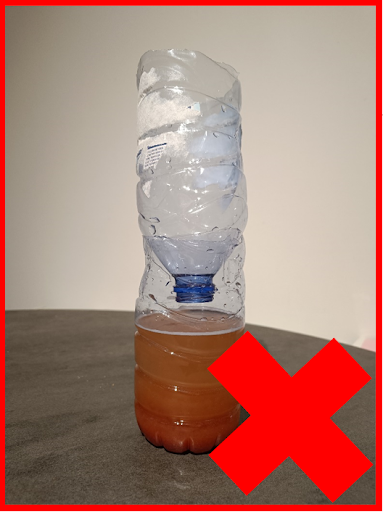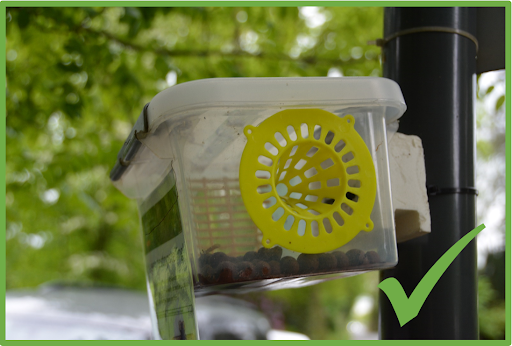Capture queens
Spring trapping via MijnTuinlab
This project starts on March 1, 2025! Sharing your traps with your municipality or beekeeping association? Refer to the MijnTuinlab project for the registration point of catches and bycatches, contributing to research on these spring traps!
The active capture of queens in spring (March - May) is one of the most commonly used methods for combating the Asian hornet in Europe. However, it is also controversial for the following reasons:
- The effect of spring traps on the number of nests in autumn has not been proven.
- Capturing queens in spring only reduces competition among queens. A nest site of a captured queen will simply be taken over by another queen.
- A selective trap is not truly selective. Native insects can still get caught in the traps. In spring, the risk of harming native biodiversity is higher as many queens of native species are also searching for nest sites.
- Protection near beehives (harps, queen excluders, capturing during June-November) is more effective in reducing the impact on honeybees.
- The only proven method to combat the Asian hornet is the destruction of nests.
For these reasons, the placement of spring traps is discouraged. It is only justified within a research context. Would you like to contribute to research on the effectiveness and selectivity of selective traps? Be sure to join the initiative below.
Study on Effectiveness and Bycatch
- Measurement is knowledge. Through this study, we aim to learn more about the spring traps (‘spring trapping’) for queens of Asian hornets.
- This will help determine if they work and what other insects may potentially be impacted.
- This research is an initiative of the Limburgse Imkersbond vzw in collaboration with Vespawatch (INBO) and ANB.
Who can participate?
- Anyone motivated to contribute to our research!
- This study runs from March 1 to May 31, 2025, but contributing for a shorter period is also very valuable.
- Anyone who has a selective Asian hornet trap at home.
- This is a trap in which insects cannot drown. Prevent insects from drowning by shielding the bait from the insects in the trap.
Do this, for example, using:
- A sponge
- A mesh divider between the liquid and the entry
- A wick container in the trap
- Absorbent clay granules
- A selective trap is equipped with an access grid with holes of varying sizes:
- Insects larger than the Asian hornet cannot enter the trap.
- Insects smaller than the Asian hornet can leave the trap.
- This is a trap in which insects cannot drown. Prevent insects from drowning by shielding the bait from the insects in the trap.
Do this, for example, using:

Example of a non-selective trap in which insects drown. ©INBO

Example of a selective trap, with absorbent clay granules. ©INBO
What do we expect from you?
Follow these instructions carefully:
- Place the trap in your garden during the period from March 1 to May 31 (preferably in a flowering environment, in the shade, and out of the rain). Queens in the spring have a strong preference for blossoms, such as those of cotoneaster.
- Register once for the project. During this step, indicate the location of your trap and define the type of trap.
- Check the trap as frequently as possible (preferably daily, but at least twice a week).
- During each check:
- Check which species and the number of individuals that have been caught in the trap. Use the app ObsIdentify for this. This way, your observations are also recorded in the Waarnemingen and Vespa-Watch databases.
- Record all catches in MijnTuinlab (of all species in the trap and also if the trap is empty!). This is very important to better study the selectivity of these traps.
- Do you find an Asian hornet?
- Place the trap in the freezer.
- After a few minutes, the hornet will be stunned, and you can free other insects from the trap without the hornet escaping.
- Use a fork to transfer the hornet into another container, which you then place in the freezer for a few hours.
- Place the trap with the lid open outside (e.g., in the sun) so that living insects can be released.
- Return your trap to its designated location and replenish the bait to keep the trap active.
- Always remove your trap after May 31. At the beginning of summer, Asian hornet queens no longer leave their nests, and you can no longer catch them. From then on, use the wick bait method to locate nests.
- If you move your trap, register it as a new trap with the new location.
How to participate?
Participation is easy with this step-by-step plan:
- Register for the Asian Hornet Spring Traps 2025 project via MijnTuinlab.
- Record your catch on MijnTuinlab preferably daily, but at least twice a week.